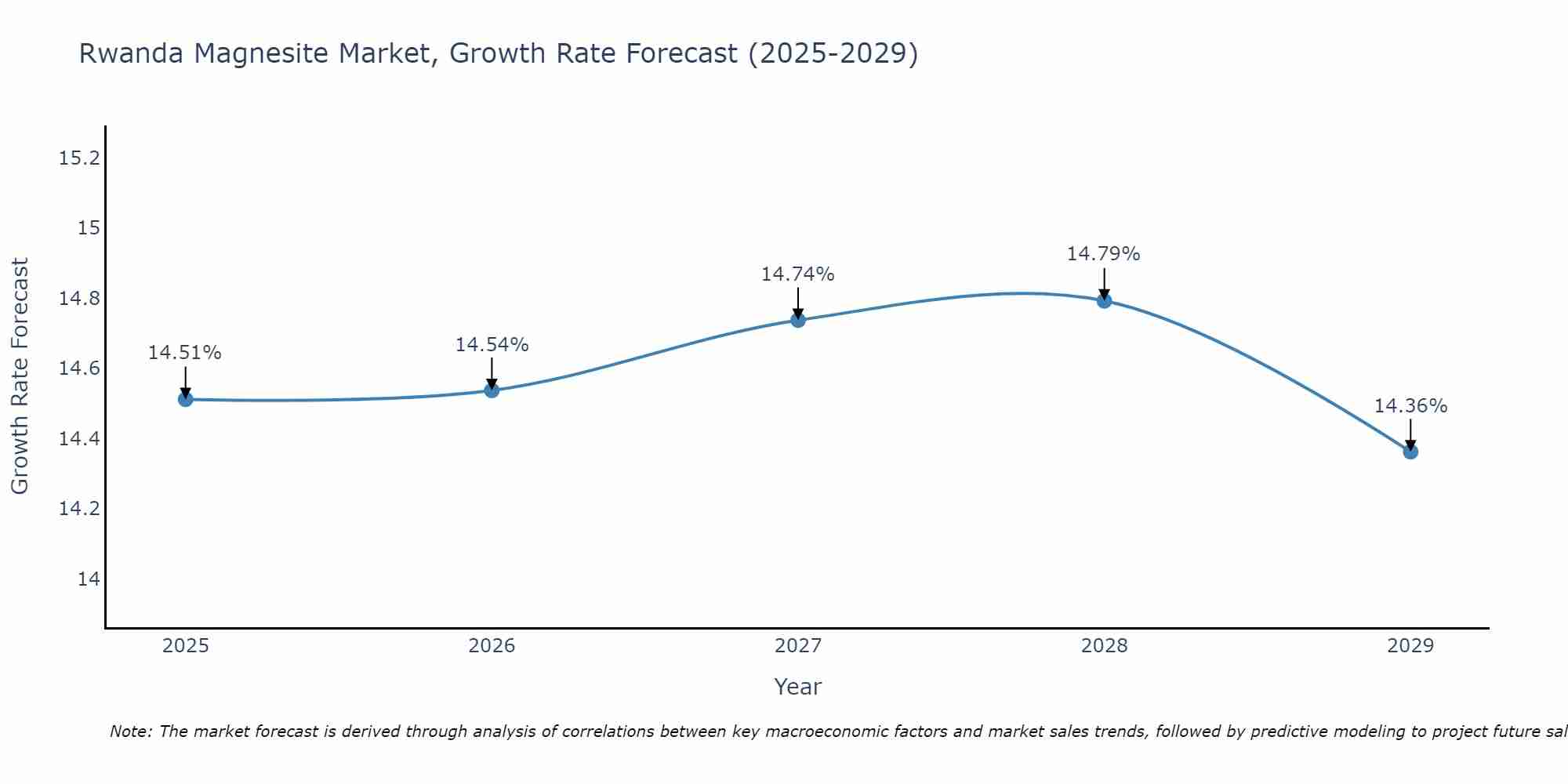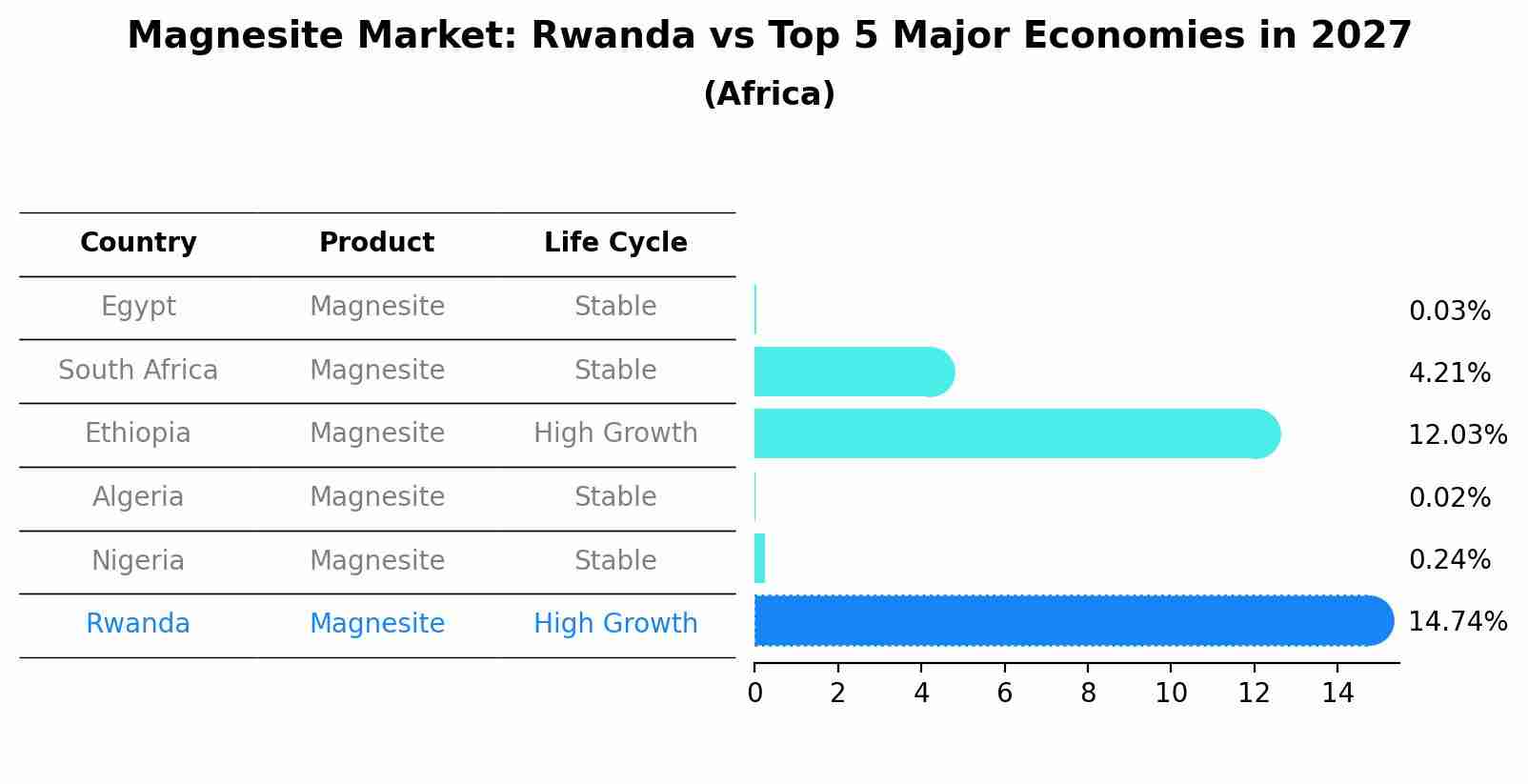Rwanda Magnesite Market (2025-2031) | Size, Companies, Segmentation, Outlook, Share, Growth, Revenue, Forecast, Industry, Trends, Analysis & Value
| Product Code: ETC4765214 | Publication Date: Nov 2023 | Updated Date: Sep 2025 | Product Type: Market Research Report | |
| Publisher: 6Wresearch | No. of Pages: 60 | No. of Figures: 30 | No. of Tables: 5 | |
Rwanda Magnesite Market Size Growth Rate
The Rwanda Magnesite Market is projected to witness mixed growth rate patterns during 2025 to 2029. Growth accelerates to 14.79% in 2028, following an initial rate of 14.51%, before easing to 14.36% at the end of the period.

Magnesite Market: Rwanda vs Top 5 Major Economies in 2027 (Africa)
The Magnesite market in Rwanda is projected to grow at a high growth rate of 14.74% by 2027, highlighting the country's increasing focus on advanced technologies within the Africa region, where Egypt holds the dominant position, followed closely by South Africa, Ethiopia, Algeria and Nigeria, shaping overall regional demand.

Key Highlights of the Report:
- Rwanda Magnesite Market Outlook
- Market Size of Rwanda Magnesite Market, 2024
- Forecast of Rwanda Magnesite Market, 2031
- Historical Data and Forecast of Rwanda Magnesite Revenues & Volume for the Period 2021-2031
- Rwanda Magnesite Market Trend Evolution
- Rwanda Magnesite Market Drivers and Challenges
- Rwanda Magnesite Price Trends
- Rwanda Magnesite Porter`s Five Forces
- Rwanda Magnesite Industry Life Cycle
- Historical Data and Forecast of Rwanda Magnesite Market Revenues & Volume By Type for the Period 2021-2031
- Historical Data and Forecast of Rwanda Magnesite Market Revenues & Volume By Dead-Burned Magnesia for the Period 2021-2031
- Historical Data and Forecast of Rwanda Magnesite Market Revenues & Volume By Fused Magnesia for the Period 2021-2031
- Historical Data and Forecast of Rwanda Magnesite Market Revenues & Volume By Other Types for the Period 2021-2031
- Historical Data and Forecast of Rwanda Magnesite Market Revenues & Volume By Applications for the Period 2021-2031
- Historical Data and Forecast of Rwanda Magnesite Market Revenues & Volume By Agriculture for the Period 2021-2031
- Historical Data and Forecast of Rwanda Magnesite Market Revenues & Volume By Chemical for the Period 2021-2031
- Historical Data and Forecast of Rwanda Magnesite Market Revenues & Volume By Construction for the Period 2021-2031
- Historical Data and Forecast of Rwanda Magnesite Market Revenues & Volume By Refractory for the Period 2021-2031
- Historical Data and Forecast of Rwanda Magnesite Market Revenues & Volume By Other Applications for the Period 2021-2031
- Rwanda Magnesite Import Export Trade Statistics
- Market Opportunity Assessment By Type
- Market Opportunity Assessment By Applications
- Rwanda Magnesite Top Companies Market Share
- Rwanda Magnesite Competitive Benchmarking By Technical and Operational Parameters
- Rwanda Magnesite Company Profiles
- Rwanda Magnesite Key Strategic Recommendations
Frequently Asked Questions About the Market Study (FAQs):
1 Executive Summary |
2 Introduction |
2.1 Key Highlights of the Report |
2.2 Report Description |
2.3 Market Scope & Segmentation |
2.4 Research Methodology |
2.5 Assumptions |
3 Rwanda Magnesite Market Overview |
3.1 Rwanda Country Macro Economic Indicators |
3.2 Rwanda Magnesite Market Revenues & Volume, 2021 & 2031F |
3.3 Rwanda Magnesite Market - Industry Life Cycle |
3.4 Rwanda Magnesite Market - Porter's Five Forces |
3.5 Rwanda Magnesite Market Revenues & Volume Share, By Type, 2021 & 2031F |
3.6 Rwanda Magnesite Market Revenues & Volume Share, By Applications, 2021 & 2031F |
4 Rwanda Magnesite Market Dynamics |
4.1 Impact Analysis |
4.2 Market Drivers |
4.2.1 Increasing demand for refractory products in industries such as steel, cement, and glass, where magnesite is a key ingredient. |
4.2.2 Growing infrastructure and construction activities in Rwanda, leading to higher demand for magnesite-based products. |
4.2.3 Government initiatives to promote mining and industrial sectors, fostering the growth of the magnesite market. |
4.3 Market Restraints |
4.3.1 Limited availability of high-quality magnesite reserves in Rwanda, leading to dependency on imports. |
4.3.2 Volatility in raw material prices impacting the production cost of magnesite-based products. |
4.3.3 Lack of advanced technologies and expertise for magnesite mining and processing in Rwanda. |
5 Rwanda Magnesite Market Trends |
6 Rwanda Magnesite Market Segmentations |
6.1 Rwanda Magnesite Market, By Type |
6.1.1 Overview and Analysis |
6.1.2 Rwanda Magnesite Market Revenues & Volume, By Dead-Burned Magnesia, 2021-2031F |
6.1.3 Rwanda Magnesite Market Revenues & Volume, By Fused Magnesia, 2021-2031F |
6.1.4 Rwanda Magnesite Market Revenues & Volume, By Other Types, 2021-2031F |
6.2 Rwanda Magnesite Market, By Applications |
6.2.1 Overview and Analysis |
6.2.2 Rwanda Magnesite Market Revenues & Volume, By Agriculture, 2021-2031F |
6.2.3 Rwanda Magnesite Market Revenues & Volume, By Chemical, 2021-2031F |
6.2.4 Rwanda Magnesite Market Revenues & Volume, By Construction, 2021-2031F |
6.2.5 Rwanda Magnesite Market Revenues & Volume, By Refractory, 2021-2031F |
6.2.6 Rwanda Magnesite Market Revenues & Volume, By Other Applications, 2021-2031F |
7 Rwanda Magnesite Market Import-Export Trade Statistics |
7.1 Rwanda Magnesite Market Export to Major Countries |
7.2 Rwanda Magnesite Market Imports from Major Countries |
8 Rwanda Magnesite Market Key Performance Indicators |
8.1 Exploration and development of new magnesite reserves in Rwanda. |
8.2 Adoption of sustainable mining practices and environmental regulations compliance. |
8.3 Investment in research and development for innovative magnesite-based products. |
8.4 Development of infrastructure for efficient extraction, processing, and transportation of magnesite. |
9 Rwanda Magnesite Market - Opportunity Assessment |
9.1 Rwanda Magnesite Market Opportunity Assessment, By Type, 2021 & 2031F |
9.2 Rwanda Magnesite Market Opportunity Assessment, By Applications, 2021 & 2031F |
10 Rwanda Magnesite Market - Competitive Landscape |
10.1 Rwanda Magnesite Market Revenue Share, By Companies, 2024 |
10.2 Rwanda Magnesite Market Competitive Benchmarking, By Operating and Technical Parameters |
11 Company Profiles |
12 Recommendations | 13 Disclaimer |
- Single User License$ 1,995
- Department License$ 2,400
- Site License$ 3,120
- Global License$ 3,795
Search
Related Reports
- ASEAN and Thailand Brain Health Supplements Market (2025-2031) | Strategy, Consumer Insights, Analysis, Investment Trends, Opportunities, Growth, Size, Share, Industry, Revenue, Segments, Value, Segmentation, Supply, Forecast, Restraints, Outlook, Competition, Drivers, Trends, Demand, Pricing Analysis, Competitive, Strategic Insights, Companies, Challenges
- ASEAN Bearings Market (2025-2031) | Strategy, Consumer Insights, Analysis, Investment Trends, Opportunities, Growth, Size, Share, Industry, Revenue, Segments, Value, Segmentation, Supply, Forecast, Restraints, Outlook, Competition, Drivers, Trends, Demand, Pricing Analysis, Competitive, Strategic Insights, Companies, Challenges
- Europe Flooring Market (2025-2031) | Outlook, Share, Industry, Trends, Forecast, Companies, Revenue, Size, Analysis, Growth & Value
- Saudi Arabia Manlift Market (2025-2031) | Outlook, Size, Growth, Trends, Companies, Industry, Revenue, Value, Share, Forecast & Analysis
- Uganda Excavator, Crane, and Wheel Loaders Market (2025-2031) | Strategy, Consumer Insights, Analysis, Investment Trends, Opportunities, Growth, Size, Share, Industry, Revenue, Segments, Value, Segmentation, Supply, Forecast, Restraints, Outlook, Competition, Drivers, Trends, Demand, Pricing Analysis, Competitive, Strategic Insights, Companies, Challenges
- Rwanda Excavator, Crane, and Wheel Loaders Market (2025-2031) | Strategy, Consumer Insights, Analysis, Investment Trends, Opportunities, Growth, Size, Share, Industry, Revenue, Segments, Value, Segmentation, Supply, Forecast, Restraints, Outlook, Competition, Drivers, Trends, Demand, Pricing Analysis, Competitive, Strategic Insights, Companies, Challenges
- Kenya Excavator, Crane, and Wheel Loaders Market (2025-2031) | Strategy, Consumer Insights, Analysis, Investment Trends, Opportunities, Growth, Size, Share, Industry, Revenue, Segments, Value, Segmentation, Supply, Forecast, Restraints, Outlook, Competition, Drivers, Trends, Demand, Pricing Analysis, Competitive, Strategic Insights, Companies, Challenges
- Angola Excavator, Crane, and Wheel Loaders Market (2025-2031) | Strategy, Consumer Insights, Analysis, Investment Trends, Opportunities, Growth, Size, Share, Industry, Revenue, Segments, Value, Segmentation, Supply, Forecast, Restraints, Outlook, Competition, Drivers, Trends, Demand, Pricing Analysis, Competitive, Strategic Insights, Companies, Challenges
- Israel Intelligent Transport System Market (2025-2031) | Strategy, Consumer Insights, Analysis, Investment Trends, Opportunities, Growth, Size, Share, Industry, Revenue, Segments, Value, Segmentation, Supply, Forecast, Restraints, Outlook, Competition, Drivers, Trends, Demand, Pricing Analysis, Competitive, Strategic Insights, Companies, Challenges
- Uganda Precast and Aggregate Market (2025-2031) | Strategy, Consumer Insights, Analysis, Investment Trends, Opportunities, Growth, Size, Share, Industry, Revenue, Segments, Value, Segmentation, Supply, Forecast, Restraints, Outlook, Competition, Drivers, Trends, Demand, Pricing Analysis, Competitive, Strategic Insights, Companies, Challenges
Industry Events and Analyst Meet
Our Clients
Whitepaper
- Middle East & Africa Commercial Security Market Click here to view more.
- Middle East & Africa Fire Safety Systems & Equipment Market Click here to view more.
- GCC Drone Market Click here to view more.
- Middle East Lighting Fixture Market Click here to view more.
- GCC Physical & Perimeter Security Market Click here to view more.
6WResearch In News
- Doha a strategic location for EV manufacturing hub: IPA Qatar
- Demand for luxury TVs surging in the GCC, says Samsung
- Empowering Growth: The Thriving Journey of Bangladesh’s Cable Industry
- Demand for luxury TVs surging in the GCC, says Samsung
- Video call with a traditional healer? Once unthinkable, it’s now common in South Africa
- Intelligent Buildings To Smooth GCC’s Path To Net Zero













